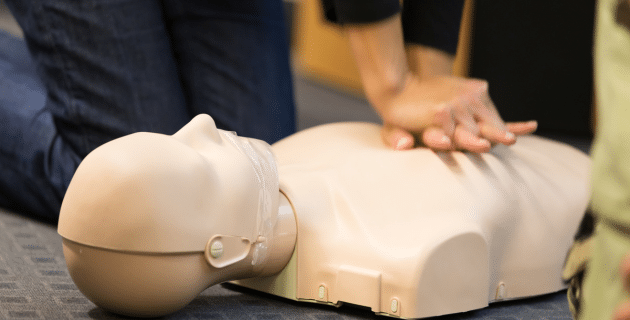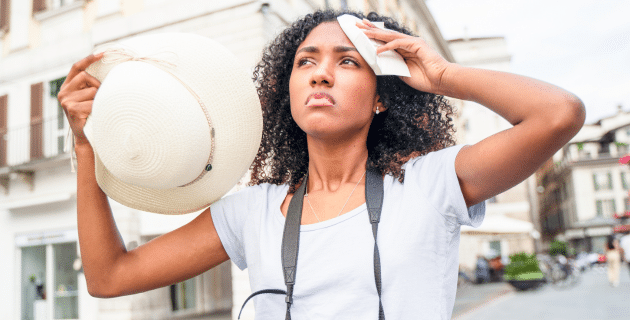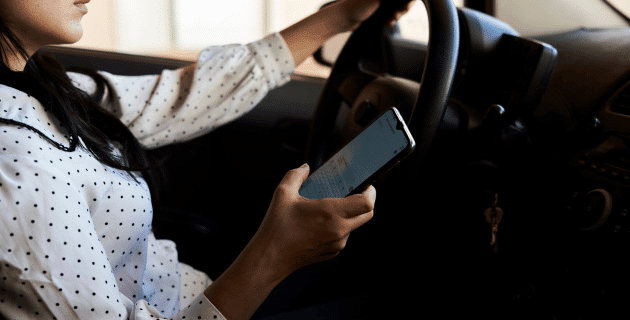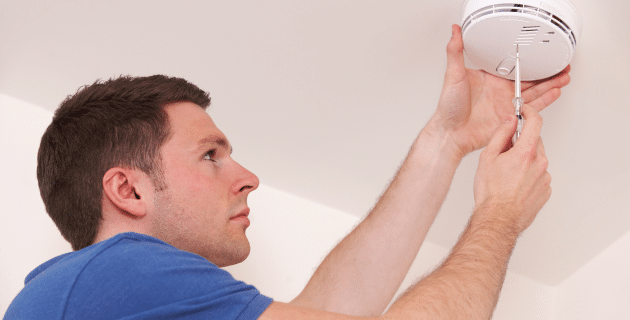
by California Casualty | Health, Pets, Safety |
It can happen in an instant. A child falls into the pool. A friend collapses in the heat. Someone chokes on a piece of food. If you know CPR, you can help.
CPR is short for cardiopulmonary resuscitation. It is a lifesaving technique used in situations when someone’s heart stops or they stop breathing. CPR helps supply blood and oxygen to vital organs. It increases your chances of survival. It can be used for both humans and pets.
Follow this guide to know what to do if you have to administer CPR in an emergency.
Before beginning CPR
- Check for responsiveness. Shout, “are you okay?” Or tap the individual gently and see if he/she moves or makes a sound. If there is no movement, no pulse, no breathing, or the person is unconsciousness, it’s time to start CPR.
- If you’re alone, and performing CPR on a child, start immediately. You’ll call 9-1-1 after 2 minutes of CPR and rescue breaths.
- If you’re alone, and performing CPR on an adult or teen, call 9-1-1 before you start CPR. Put your phone on speaker.
- If you’re with others, point to one person. Tell him or her to call 9-1-1 and then begin CPR. If you don’t specify the person, there’s a chance that no one will make the call. If there might be an automated external defibrillator (AED) nearby, send someone to get it as well.
- For pets, an emergency vet is the equivalent of 9-1-1. See the last section for steps to take in performing CPR.
CPR for Adults
CPR for adults also applies teens. The general rule is that if the person has entered puberty, this technique may be used.
Step #1: Put the person on their back on a flat firm surface. Kneel beside them.
Step #2: Do 30 chest compressions to get the blood flowing.
- Place your two hands centered on the person’s chest.
- Make sure your shoulders are directly above your hands. Lock your elbows.
- Push down at least 2 inches hard and fast, about 100-120 compressions per minute.
- Let the chest return to normal between compressions.
Step #3: Look, listen and feel for breathing.
- Look to see if their chest is rising and falling.
- Listen for breathing sounds.
- Feel their breath against your cheek.
Step #4: Give 2 rescue breaths to deliver oxygen to the organs.
- Tilt the head and lift the chin to open the airway.
- Make sure there is nothing in the mouth obstructing the airway. If there is, sweep it out with your fingers.
- Pinch the nose shut, while you take a normal breath.
- Put your mouth over the person’s mouth and make a complete seal.
- Blow the breath into their mouth for one second. Watch the chest rise. If the chest does not rise, try repeating the head tilt and breath. If the chest still doesn’t rise, there may be something blocking the airway.
- Repeat the process of blowing for a second breath.
Step #5: There may be an AED if you are in a public place. This machine delivers an electric shock to the heart. It can help restore a heart’s rhythm. After five cycles of CPR, turn on the AED and follow the voice prompts.
CPR for Children (1-12 years)
A child’s airway is more delicate than an adult’s airway. If you approach CPR on a child as you would an adult, you could do harm. You will need to be more careful with the head tilt and the compression strength and depth.
Step #1: Place the child on his/her back on a flat surface. Kneel next to the child.
Step #2: Do 30 chest compressions.
- Put heel of one hand on the breastbone, just under the nipples. Make sure your hand is not on the end of the breastbone.
- Push down about one-third of the child’s chest, about 1.5 to 2 inches. Aim for 100-120 compressions per minute.
- Let the chest return to normal between compressions.
Step #3: Look, listen and feel for breathing.
- Look to see if their chest is rising and falling.
- Listen for breathing sounds.
- Feel their breath against your cheek.
Step #4: Give 2 rescue breaths for every 30 compressions.
- Lift the chin to tilt the head back. Be careful not to tilt the head too far.
- Make sure there is nothing in the mouth that is blocking the airway.
- Pinch the nose shut, while you take a normal breath.
- Put your mouth over the child’s mouth and make a complete seal.
- Blow the breath into their mouth for one second. Watch the chest rise. If the chest does not rise, try repeating the head tilt and breath. If the chest still doesn’t rise, there may be something blocking the airway.
- Repeat the process of blowing for a second breath.
Step #5: If an AED with pediatric pads is available, use it after five cycles of CPR. Pediatric pads adjust the energy level used. You can use adult pads for children ages 8 and older.
CPR for Babies (under a year)
Babies have flexible bones and are still developing. You must take care with the force of your compressions and breaths.
Step #1: Place the child on his/her back on a flat surface such as a table or floor.
Step #2: Do 30 chest compressions.
- Use only 2 fingers to provide compressions in the center of the baby’s chest.
- Place your fingers in the center of the chest just below an imaginary line between the nipples. Compression depth should be about an inch and a half.
- Do 30 gentle chest compressions. Aim for 100 compressions per minute.
Step #3: Look, listen and feel for breathing.
- Look to see if their chest is rising and falling.
- Listen for breathing sounds.
- Feel their breath against your cheek.
Step #4: Give 2 rescue breaths for every 30 compressions.
- Gently tilt back the baby’s head and lift its chin to open the airway.
- With your breaths, do not use the full force of your lungs. Use your cheeks to puff air into the mouth and nose.
- Give one gentle puff of air for the duration of a second. Wait one second and give a second puff.
- Watch to see if the baby’s chest rises. If it doesn’t rise, repeat the head tilt, and give another breath.
Step #5: If available, use the AED only with pediatric pads, after five cycles of CPR.
CPR for Pets
You also may perform CPR on a pet. Make sure to only do it for unconscious animals, as even a beloved family pet can bite from pain or fear. The following guidelines are geared toward our fur babies.
Step #1: Place the pet on a flat surface such as a table or floor. Kneel or stand behind the pet.
- For large dogs, put the dog on its back and compress its chest as you would a human.
- For small dogs and cats, lie them on their side and compress the side of the rib cage or position the animal on its back and press on both sides of the rib cage.
Step #2: Do 30 chest compressions.
- Compress at least a third the depth of the chest, but not more than a half the depth.
- For small dogs and cats, do compressions with one hand to avoid pushing too hard.
- For dogs over 60 lbs.: do 60 compressions per minute.
- For animals 11 to 60 lbs.: do 80-100 compressions per minute.
- For animals 10 lbs. or less: do 120 compressions per minute.
Step #3: Give 2 rescue breaths.
- Make sure the pet’s windpipe is as straight as possible. The head should be flat on the table or floor with tip of nose aligned with the spine.
- Open the animal’s mouth, and make sure the air passage is clear. Remove any objects.
- Open your mouth. Put it over both nostrils of your pet. For large dogs, close the pet’s jaw tightly and breathe into the nose. For small dogs and cats, cover the animal’s nose and mouth with your mouth as you breathe.
- Blow hard and quickly and make sure you see the chest rise.
Step #4: Alternate breaths with compressions. There should be 30 compressions to 2 breaths.
Step #5: Since 9-1-1 is not an option for pets, get someone to help you get your pet to an emergency vet. Continue CPR on the drive over.
CPR training is available for adults, children, babies, and pets. Contact your local Red Cross for information on human CPR and ask your veterinarian about animal CPR. Keeping your pet fully insured also will help should an emergency arise.
This article is furnished by California Casualty, providing auto and home insurance to educators, law enforcement officers, firefighters, and nurses. Get a quote at 1.866.704.8614 or www.calcas.com.

by California Casualty | Safety, Travel |
It’s going to be a hot one. When you’re traveling, that can be a problem. Vacationing in extreme heat is not only uncomfortable, but it can put you in real danger. Here’s how to keep your cool when you’re traveling or vacationing in extreme heat this summer.
Avoid the hottest hours.
The sun is highest at midday but that’s not when the air is the hottest. While it depends on your geographic location, generally the hottest times of day are between 3 and 6 pm. It’s a good idea to avoid being outside during those hours. Take a siesta in your vacation home. Plan an itinerary that includes outdoor adventures earlier in the day or in the evening. The advantage of traveling in the summer is that sunset is very late in some countries so there’s extended daylight well into the evening hours.
Pro Tip: Check for evening discounts. Some attractions may offer them.
Wear the right clothes.
Look for white or light-colored clothing made of rayon, cotton, or linen. Those fabrics will allow heat to pass through and keep you cooler. Avoid synthetics and dark colors which absorb heat. Choose loose styles that allow your body the space to “breathe” and sweat. Don’t forget your hat and sunglasses; both will help.
Stay hydrated.
You sweat more when it’s hot, and so you need to replenish the water and nutrients lost by your body. Try to drink every 15-30 minutes even if you’re not thirsty. Stick to water or sports drinks that have electrolytes. Avoid caffeinated drinks and alcohol, both of which are dehydrating.
Pro Tip: Set reminders on your phone to hydrate. There are apps available that can make it fun.
Choose the right foods.
When we eat a lot of heavy foods, our bodies work hard to digest them. In the process, that creates heat. Choose lighter fare instead. Hydrating foods like fruits and salads do double duty and provide extra water. Cold foods, like ice cream and smoothies, naturally help to cool down your body. Salty snacks such as salted nuts, popcorn, and trail mixes help replace electrolytes.
Get wet.
If you can’t get to a swimming pool to cool down, there are some creative options. Take a cold shower or dunk your head under the faucet. Wet hair will make breezes feel cool. Hold your wrists under cool running water. Wet your hat or wear a damp evaporation scarf. All of this will help lower your body’s core temperature.
Pro Tip: Invest in a breeze fan and bring the misty breeze along with you.
Use an umbrella.
Think of it as your personal shady spot. By keeping the sun’s rays off you, an umbrella will make you cooler. Heading to the beach? Bring a tent or umbrella for a similar effect. In general, it’s a good idea to seek out shade wherever you go.
Look for places to cool off.
Look for malls, libraries, museums, and galleries that can offer quick relief. Plan for those inside activities during the hottest part of the day. You may want to call ahead to confirm that they have air conditioning. It is not necessarily the norm in countries outside the U.S.
Don’t overdo it.
Exercise raises your core body temperature. Limit physical activities in the heat. Avoid climbing hills or doing any activities that require exertion. These activities will only put extra stress on your body as it’s trying to deal with the heat.
Take care of your car.
Extreme heat can affect your car, too. If you’re on a road trip, make sure to be aware of the effects. The heat could make it hard for your battery to hold a charge. It can affect tire pressure and even cause tires to overheat, putting you at risk for a blowout. Air conditioning puts extra stress on the engine. Before you plan a road trip in the summer, have your vehicle checked to make sure it’s in its best shape to travel.
Acclimate yourself before your trip.
You can adjust your body to the heat before your vacation. Go to a sauna or steam room. Work up to spending 30-40 minutes in that sauna/steam room over 7-10 days. It allows your body to get used to the heat.
Beware of heat stroke.
Know the signs of heat stroke and a place where you can get medical attention while traveling. Children and the elderly are especially vulnerable so you will want to take extra precautions to keep them cool.
Safe travels and enjoy the journey!
This article is furnished by California Casualty, providing auto and home insurance to educators, law enforcement officers, firefighters, and nurses. Get a quote at 1.866.704.8614 or www.calcas.com.

by California Casualty | Finances, Safety |
Your cell phone is your trusted companion, your admin assistant, social director, banker, compass, and connection to the world. If it ends up in the wrong hands, you could be in deep trouble.
At best, a hacked phone could make life difficult. At worst, it could result in thousands of dollars in identity theft. Here’s what you need to know to protect your cell phone from hackers.
Update to the latest version.
Many hackers take advantage of out-of-date operating systems. Whether you have iOS or Android, make sure to update your phone to the newest version. This will give you the latest security fixes.
Avoid fingerprint and facial recognition.
Hackers can take your fingerprints from a drinking glass to open your phone. They also can use photos of you to get past facial recognition settings. Use a pin instead and make sure you’re the only one that knows it. Change it regularly, at least once a year.
Pro Tip: Don’t set your phone to automatically unlock, even at home. If you’re an iOS user, disable Siri access from the lock screen.
Avoid unsecured connections.
Public WiFi is available nearly everywhere. While it makes our lives easier, it comes with security risks. Use caution if you’re on an unsecured network. Never access your bank account or shop online unless you’re on a secure network with a lock icon.
Pro Tip: Use a VPN, a virtual private network that protects your identity while working on a public network. VPNs usually have an associated fee.
Use strong passwords for your apps.
Avoid pet names, birthdays, and other personal information that may readily be available on social media. It makes it easy for hackers to guess your password. The best passwords are complex and unique. Password managers make it easy to set distinct passwords without having to memorize them.
Pro Tip: For an added layer of security, use different email addresses: one for financials and one for social media.
Don’t just download any apps.
Anyone can create an app, including hackers. If you download the wrong app, you could be adding malware that can steal from your phone. Make sure the apps you’re using are from reputable companies. Take a few minutes to review your apps and delete any that aren’t verified.
Don’t save your information.
It may be convenient to save your credit card information on online shopping sites. Check out as a guest instead. Be selective when you give out your personal information.
Freeze your credit.
Cell phone providers use the National Consumer Telecom & Utilities Exchange. Freeze your credit with them and with the big 3 credit unions: TransUnion, Equifax, and Experian. This will ensure that no one can open new accounts in your name.
Disable WiFi, Bluetooth and Cellular Data if not using your phone.
A hacker can’t hack you if you’re not connected. When in a public place, you can disable access to the internet. One easy way is to turn on Airplane Mode. You also can use your user’s manual to find out how to disable connectivity.
Consider anti-virus software.
There are two schools of thought on whether security software is necessary for smartphones. Some say it’s unnecessary and others recommend it. You may consider it as an additional layer of protection.
Know how to control your phone remotely.
Settings and apps allow you to remotely lock and erase your phone if it’s stolen. Make sure you know how to use them. There is the “Find My Phone” option in iCloud and the Android Device Manager in Google.
Back up your data.
Make sure you regularly back up your data to the cloud or your computer. If you’re hacked, you’ll still have access to that information.
How to Know if Your Phone Has Been Hacked
You may not realize the moment your phone is hacked. Initially, it may present as a technical issue. Malware can cause this with its malicious code. Watch for these telltale signs:
- Your phone loses charge quickly.
- Your phone runs very slowly, freezes and crashes.
- You notice unusual activity on your online accounts.
- There are popups or changes to your home screen.
- You receive unfamiliar calls or texts.
If you believe your phone was hacked, install and run anti-virus protection. Delete any risky apps, texts, and files. If the damage is extensive, you can always wipe and restore your phone to factory settings. Then you’ll be able to address the damage done by hackers to your accounts, both financial and social.
This article is furnished by California Casualty, providing auto and home insurance to educators, law enforcement officers, firefighters, and nurses. Get a quote at 1.866.704.8614 or www.calcas.com.

by California Casualty | Safety |
You’ve probably heard a lot about identity theft, but it could never happen to you, right? Unfortunately, it’s more common than you think. Every 22 seconds, someone has his/her identity stolen in the U.S.
You could be the next victim. Learn the signs of identity theft and the strategies to help protect your identity.
Types of Identity Theft
Identity theft happens when someone uses your personal information to steal from you. They can take over your personal accounts. They can ruin your credit. They can take out loans in your name, leaving you on the hook for thousands of dollars or more.
There are many types of identity theft. Here are some of the most common:
• Bank fraud
• Credit card fraud
• Employment fraud
• Tax-related fraud
• Government benefits fraud
• Insurance fraud
• Loan or lease fraud
• Medical services fraud
• Online shopping fraud
Watch for These Warning Signs
Identity theft can easily happen without you knowing it. Be on the lookout for signs that show someone is fraudulently using your information.
1. You do not recognize charges on your credit card or bank account. Check your credit card statement each month, or online more frequently if you feel you may be a victim of identity theft. If you see charges that you didn’t make, contact your credit card company. You can dispute those charges, and change your account number. Similarly, if you see withdrawals on your bank statement that you didn’t make, notify your bank immediately. While they may not be able to refund that money, they can put a hold on your account and open a new one for you.
2. You are getting calls from debt collectors. If you’re getting calls from debt collectors for a purchase you did not make, that’s a huge red flag. It’s possible someone made a purchase in your name. Get the information from the debt collector. Contact the fraud department of the creditor who says that you owe the debt. Request copies of the transaction. Dispute the charge. Close or change the account where the debt was originally charged, whether it’s a bank account or credit card.
3. You receive notifications of password changes you didn’t make. If you get a notification that you changed your password, and you didn’t make the change, take action right away. That means someone was able to access your account. Notify the institution. Change the initial password to something new. If you use that same password elsewhere, change it there, too.
4. You get texts with verification codes. If you get a verification code from PayPal or other services, that’s a sign that someone is using one of your personal accounts. Change your password immediately and contact the account provider.
5. Your credit score suddenly drops. Perhaps you’re denied a loan because your credit report shows unexpected problems. Or maybe you checked your credit score and it’s much lower than it was. Order a credit report to get detailed information. You can get a free report from the major credit bureaus: Equifax, Experian, and TransUnion. Then you can correct any inaccuracies for future reporting.
6. You’re missing mail and bills. Identity thieves sometimes use a change of address form to reroute your mail. That’s one way they can get personal information mailed right to them. If you notice that mail is missing, especially bills, contact those companies and make sure the address on file is the correct one.
7. You’re getting unfamiliar bills. If you’re receiving medical bills for services that you didn’t receive or bills for items you didn’t purchase, someone is pretending to be you. Contact the provider and let them know.
8. The IRS has more than one tax return in your name. This happens when someone files a tax return to get your refund. You will need to contact the IRS to resolve the situation. You can get a copy of the fraudulent return and take steps to protect your social security number in the future.
How to Protect Your Identity
Follow these steps to help prevent identity theft.
• Guard your social security number. Most places will ask for the last four digits only. Do not share the full number unless you are certain it is secure and safe.
• Watch out for phishing scams. Don’t respond to unsolicited calls or emails. Don’t click on links in those emails either. Never enter your personal information in response to an email.
• Keep close tabs on your billing cycles. If bills do not appear, you will know what is missing.
• Read your credit card statements and look for small charges, too. Scammers often start with a small test before making a big purchase.
• Create complex passwords for your accounts. Avoid using complete words and don’t use the same password for multiple accounts. Initiate 2-step verification for an extra layer of protection. Avoid storing passwords on your devices.
• If you bank online, install virus protection on your computer and mobile devices.
• Don’t use public WiFi. Use a secure VPN for your devices. Keep devices updated with the latest security fixes.
• Freeze your credit. This prevents anyone, including you, from opening a loan or credit card in your name. When you’re ready to do so, you can unfreeze your credit temporarily.
• Sign up for a credit card alert for purchases more than a certain amount. That will give you an instant notification if someone happens to use your card and spend over that amount.
• Use an ID theft protection service like Cyber Scout, offered at no additional cost to you with every California Casualty policy.
This article is furnished by California Casualty, providing auto and home insurance to educators, law enforcement officers, firefighters, and nurses. Get a quote at 1.866.704.8614 or www.calcas.com.

by California Casualty | Auto Insurance Info, Safety |
We all want to think that we’re good drivers. The truth of the matter is, every once in a while, we get distracted…some of us more than others. We reach for that French fry. We have an argument with the kids in the backseat. We hear our phone ding and instinctually grab it to look at a message. We know better, but we do it anyway.
In honor of April, Distracted Driving Awareness Month, here’s a reminder about the dangers of distracted driving and why it’s important to stay focused behind the wheel.
Distracted driving by the numbers
Nine people die each day in crashes caused by distracted driving, reported the Centers for Disease Control (CDC). Over 3,100 people were killed and 424,000 injured due to distracted driving in 2019. One in five who died weren’t even in a vehicle. They were walking, riding their bikes, or simply at the wrong place at the wrong time.
Distracted driving deaths have increased by 12% from 2020 to 2021, reported the National Highway Traffic Safety Administration (NHTSA). Drivers aged 18 to 34 are more likely to die due to distracted driving than any other age group. It’s no surprise that teens, with their inexperience behind the wheel and the world at their fingertips, are at greater risk for distracted driving. A survey of U.S. high school students found that 39% admitted to texting while driving in the past 30 days.
What is distracted driving?
Distracted driving is defined as any activity that takes focus off of the road. There are three major types of distractions, as defined by the CDC:
- Manual: This causes you to take your hands off of the wheel, such as when you are reaching for something. If you’re eating while still looking at the road, that could be a manual distraction.
- Visual: This is anything that takes your eyes off the road ahead. If you are rubbernecking, fiddling with the radio, or even looking at your GPS, that could be a visual distraction.
- Cognitive: This type of distraction takes your mind off driving. If you are texting or emailing while driving, that’s a cognitive distraction. If you’re engaged in conversation, daydreaming, or worrying, that takes your attention away, too.
Reaction time and distracted driving
You may think that glancing at your phone to read a text is no big deal, and takes no time at all. Consider this. If you’re reading a text while driving 55 mph, you’ll probably take your eyes off the road for 5 seconds. According to NHTSA, that’s like driving the length of a football field with your eyes closed. Five seconds is more than enough time to whiz past a stop sign, slam into a car that suddenly brakes in front of you, or seriously hurt or kill a pedestrian. Texting while driving increase your chances of crashing by 2300%.
Even hands-free devices can be a mental distraction. An AAA study found that it takes 27 seconds to regain your full attention after engaging with your hands-free device. At 25 mph, that’s enough time to travel nearly three football fields.
How distracted driving affects your insurance
Many states have bans for handheld cell phones while driving. It is your responsibility to know the local laws, even if you’re traveling out of state. If your state has banned cell phone use, even holding your phone at a stoplight can get you a ticket. If the engine is turned on, your car is considered in motion.
Tickets for illegal cell phone use can come with hefty insurance penalties. Forbes noted that if you are found to be distracted driving, it could raise your insurance rates as much as 41% depending on the state where you live. The average is an increase of 16%. So, in addition to the damage that distracted driving can do to people and property, it can affect your wallet, too.
Tips to stay focused
Follow these tips to keep your eyes on the road, your hands on the wheel, and your mind on driving.
-
- Avoid multitasking while driving. Do everything you need before you start the car. Set up the GPS. Choose radio presets. Send any texts you need to send before you start the car.
-
- Leave your phone in a secure place. Enable the “do not disturb” setting while you’re driving. Your phone will silence texts and maybe even send an automatic response text that tells people you’ll reply to them when you’re not driving.
-
- When in doubt, pull over. Find a parking spot or lot to enter an address in a GPS or call or text someone. Plan breaks to eat, text, and talk.
-
- Lead by example. If you have teens or pre-teens, they are watching your driving habits and taking note.
-
- As a passenger, you can help the driver focus on the road. Limit distractions around them, and speak up if you see them starting to text or otherwise shift their attention.
-
- Educate yourself and your loved ones on the dangers of distracted driving.
Safe travels.
This article is furnished by California Casualty, providing auto and home insurance to educators, law enforcement officers, firefighters, and nurses. Get a quote at 1.866.704.8614 or www.calcas.com.

by California Casualty | Helpful Tips, Homeowners Insurance Info, Safety |
If you’ve ever accidentally set off the smoke alarm, you know how loud it can be. But that loud beeping is actually a good thing. Smoke detectors give us that important warning to get safely away in case of a fire. Some detectors do double duty and also alert to carbon monoxide.
However, don’t assume your smoke detectors are working if you’ve installed them once and then never touched them again. Batteries wear out, and detectors have a lifespan of only about 10 years. That’s why it’s important to test yours regularly and there is no better time than when you are spring cleaning.
Two types of detectors
You may have a battery-powered smoke detector or yours may be hard-wired. They look the same from the outside but they’re a little different.
-
- A hard-wired detector is connected to your home’s electrical power with a cable that runs behind your wall or ceiling. They usually have a battery backup in case the power goes out. It is recommended that these detectors are installed by a professional electrician.
-
- The battery-powered detector snaps into a plastic base that is screwed onto the ceiling or wall. In many newer models, batteries are non-removable and come with a 10-year warranty.
Follow these steps
Both types of smoke detectors have a test button that allows you to check if they are working. Test your smoke detectors at least twice a year, once in the spring and once in the fall, and replace them as needed.
Step 1: Let family members know you’ll be testing.
A smoke alarm could cause family members to think there is a real emergency, so let them know that you are going to run a test. Since the sound could frighten small children and pets, you may want to test while they are not around. In addition, if your smoke detector is connected to an alarm company, notify them or you could have the fire department show up at your door.
Step 2: Position someone away from the detector.
Ask a family member or friend to stand on another level of the house, to make sure the alarm is heard. You want to make sure that the warning is heard downstairs in the basement and upstairs, in case someone might be there when it sounds.
Step 3: Press and hold the test button.
You may need to stand on a chair or a ladder to reach the button on your detector. You can use a broom handle if you are able to reach it that way. Note that it may take a few seconds to start. You will hear a loud siren. If there is no sound or a weak one, the batteries and/or the detector need replacement. Make sure to repeat this test with every smoke detector in the house or apartment.
Pro Tip: Some smoke detectors can go into programming mode if you hold the button too long. Wait for the detector to return to normal before testing it.
Step 4: Try this way to check your detector’s sensor.
The test button checks that your detector is powered. However, it doesn’t check the smoke sensor. You can do so with an aerosol spray that you can purchase for a few dollars at a hardware store. Follow the directions on the can to spray the “smoke.” This is a safer way to check the sensor than lighting matches. After the test, you can use a handheld vacuum to remove the material from the detector.
Pro Tip: Some detectors have a button to push to stop the alarm. Find out if yours has one before you run this test.
Other important tips
-
- If you have a detector where you have to change the batteries, you should replace them twice a year. (When we change the clocks is a great time to do that.) If your smoke detector is older than 10 years, you should replace it even if it is working.
-
- Dust and dirt build-up can affect your detector. Keep your detectors clean.
-
- Don’t paint your detector to match your décor. That can interfere with their ability to detect smoke.
-
- Make sure you have enough detectors in your home or apartment. You should have one in your kitchen, but 10 feet away from cooking to avoid false alarms. You also will want to place them inside every bedroom and outside each sleeping area, on every level of your home, and in places where you keep flammable substances like the garage.
You want to be fully prepared in case of a fire, and not just with smoke detectors. Talk with your insurer about your home and property to ensure that you are fully covered.
This article is furnished by California Casualty, providing auto and home insurance to educators, law enforcement officers, firefighters, and nurses. Get a quote at 1.866.704.8614 or www.calcas.com.






